“Are you nuts?” my buddy, Dave, asked.
It was not a rhetorical question. I got the impression that he was legitimately concerned about my mental health. He did not smile and was obviously waiting for an answer.
I had just informed him that I was planning to stalk turkeys with my recurve. No big deal, right? So why was he in such a lather? His eyes were bugging out of their sockets.
“Relax,” I said. “I’m not crazy in the least.”
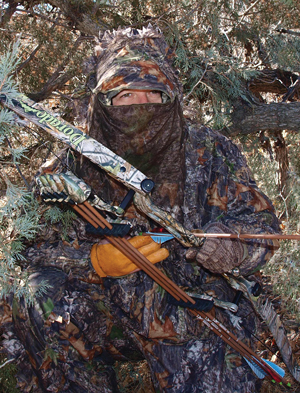
3-D camouflage can make a huge difference whenstalking turkeys.
It was not the first time my sanity was questioned by a bowhunting pal. I occasionally employ an unorthodox approach (AKA “a stupid move”), and as a result I am cast as a lunatic by friends and family. For the most part, tried and true hunting methods are the way to go, but deviating from them can sometimes be a more entertaining and rewarding option.
I would be the first person to admit that setting up in full camouflage (or better yet, in a blind of some sort) and calling to turkeys is the highest-odds tactic for bagging these keen-eyed birds, whether you’re hunting with a bow or a shotgun. Is foot-hunting gobblers a possibility? Many bowhunters would say “absolutely not!” I used to be one of those guys.
There was a time when I would not head into the turkey woods without a good pop-up blind and decoys. Not too long ago, portable blinds opened up a whole new world of opportunities for archers, especially when it came to putting a gobbler in the freezer. I have enjoyed hunting turkeys from pop-up blinds and bagging a tom or a hen with a bow is always an accomplishment, regardless of the method. But a while back I discovered just how effective I could be at sneaking up on a flock of unsuspecting birds.
It was the fall season here in Colorado, and I was spending most of my time pursuing the majestic wapiti. Every few days I would take a break to chase grouse and turkeys. My tendency each autumn is to become consumed by my big game aspirations, and so I try to find diversion from this obsession to maintain perspective. Hunting is supposed to be enjoyable, not frustrating, and those big deer can vex an archer more than just about any other species. I find relief in bird hunting. It’s sort of like fishing. There is no pressure.
As I strolled casually along a well-worn game trail, I heard the faint rustling and calling of turkeys up ahead. It took several minutes before I caught movement at about 70 yards. I ducked to avoid detection. The vegetation was tall and dense—perfect for a stalk. As I crept closer, I realized it was a group of around a dozen hens. Colorado allows hunters to harvest both males and females during the fall season. Since I was not opposed to putting my tag on a hen, I was all in. Sinking to my knees, I began to crawl and did my best to be silent. I knew I was invisible, staying well inside the heavy grasses.
Twenty minutes later, I was within bow range. The hens would separate while feeding, then regroup after locating each other with soft clucks and purrs. At one point I sighted the bobbing head of a wayward hen. As she hustled toward the calling of her girlfriends, I zapped her at ten yards through some tall weeds. She dropped in her tracks, barely fluttering her wings. That was my first successful stalk on a turkey, and I was hooked. Since then, I have bagged five more birds while foot-hunting and my favorite pop-up blind is gathering dust in the garage.
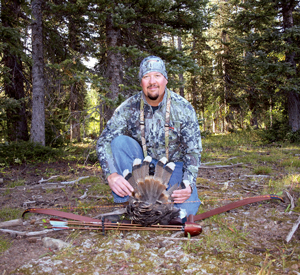
Jeff bagged this hen during Colorado’s fall season.
This past spring I was again in pursuit of Meleagris gallopavo. I rose early one morning and hurried in the dark to a location where I had put a flock of birds to bed the previous evening. While I had some camo netting in my pack (just in case), I was determined to put on a catlike sneak. At first light, I readied myself for action and crow called, hoping for a response. I hid behind a tree and listened intently for a reply or a noisy fly down. This was an ideal spot, close to several roosting trees and a water hole. Perhaps I would see where the turkeys landed and be able to plan my stalk accordingly. After my initial crow caw, I got no response. Evidently, they had descended from their perches prior to my arrival. I waited a few minutes and went to work on my slate and my box call, starting out softly but gradually increasing the volume.
A half-hour later a boss beard suddenly appeared along a field edge in the distance and began working away from me into a patch of trees. I quit calling and started tiptoeing in his direction. Once he was out of view, I assumed he could not see me. I stayed well within the available cover en route while closing the gap.
After reaching the trees, I crouched low to the ground and began scanning the forest for any sign of the big bird. That was a futile effort. Suddenly a gobble rang out, and I was quickly able to pinpoint the sound’s origin. There he stood at 60 yards in dusky profile. No wonder he had been impossible to spot, since he blended in perfectly with an equally dark tree trunk. He was not looking my way, but I hesitated to undertake a stalk since the cover was not sufficient and I could see one of his eyes. Patience was required.
I waited for him to turn completely away from me. He fanned his tail, strutted a bit, and faced away. I knew this was my chance. There was a rather large opening I had to cross in order to get within bow range, but it was now or never. I slipped quickly but quietly through the expanse and reached a big spruce, snuggling up to it. The tom stood motionless, and I assumed he was listening for me. “He knows I’m here,” I told myself. “He’s going to take off any second now.” I drew my bow and aimed at the base of his fan. He was not quite 20 yards away. The string rolled from my leather-clad fingertips, the broadhead thudding an instant later. He wilted to the ground after taking only a few steps. My heart pounded wildly as my whole body began to shake.
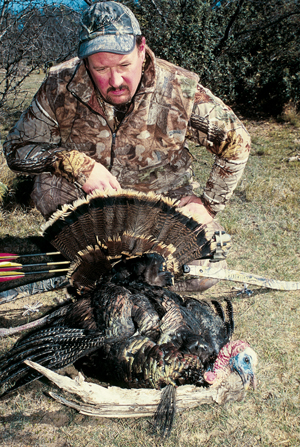
A nice tom taken while foot-hunting.
I walked over to retrieve my bird. Sporting an eight inch beard, he was not a whopper. But he was good enough for me, especially since I had stalked him down. A resounding sense of achievement filled my chest as I admired my trophy.
On most turkey hunts I wear 3-D camouflage, which is a real advantage. Believe it or not, you essentially become your own blind. Ghillie suits or Leafy-Wear attire can make you invisible to a gobbler’s superior eyesight. By donning a 3-D suit and sneaking silently through the woods, I have achieved success on turkeys. It took me a while to get smart, though. Initially I did not realize just how effective such an outfit could be. Then I gave it a shot, and now I’m sold 100 percent.
Since bowhunting is largely a mental game, you must have complete faith in whatever you’re doing. If you do not believe that stalking turkeys will work, it won’t. At first you’ll doubt your ability to achieve the impossible. You must dispel those feelings of insecurity. Friends may scoff at you and question your sanity. That’s par for the course. You’ll get over it. Practice sneaking up on backyard squirrels, your kids, even the family cat. Eventually the confidence will come.
In the end, once you’ve stalked down and arrowed a turkey, you will experience a newfound sense of accomplishment and you will never forget that moment of exhilaration. It will be the result of much hard work and extreme effort, but with time you will come to understand that it wasn’t just a fluke. Then it will become a habit.
Equipment Notes: For turkey hunting, it’s not necessary to tote a heavy-poundage bow. I normally use my big game rig, but even a 30# bow will do the trick. I like fairly heavy arrows and 150-grain Snuffer broadheads. Expandable heads are an iffy proposition when hunting with a stickbow and are not recommended.


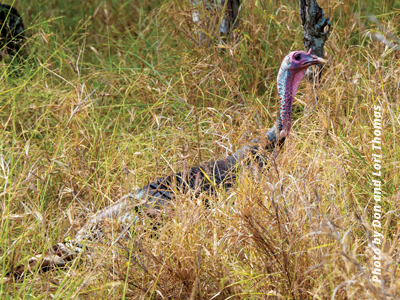



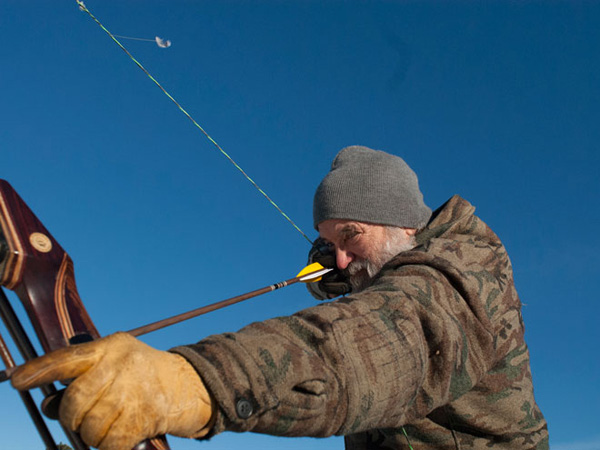
Seen the red and blue fletching on the arrows.bad choice when turkey hunting.